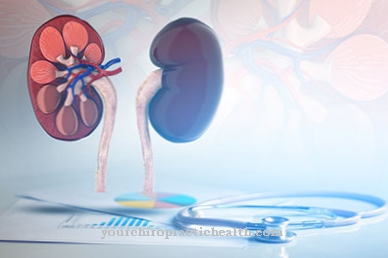The Menkes syndrome is an X chromosomal recessively inherited disorder of copper metabolism in which the intestine does not sufficiently absorb the trace element. The undersupply of copper manifests itself in the muscles, in the nervous system and in the skeleton. The disease has so far been incurable and has a poor prognosis.
What is Menkes Syndrome?

© Yulia Furman - stock.adobe.com
The Menkes syndrome is also known as Menkes disease designated. This disease corresponds to a hereditary metabolic disease. The disease mainly involves a disruption of the copper metabolism. Copper is the third most abundant trace element in the human body. The skeleton and muscles as well as the brain and liver contain copper. In addition, the substance is involved in the formation of connective tissue.
As a component of enzymes such as superoxide dismutase, the trace element also protects the body from free radicals and oxidative stress. Apart from these functions, copper also takes on tasks in energy generation. Accordingly, a copper deficiency has a negative effect on the body.
A chronic copper deficiency is present in the context of Menkes disease. The syndrome is named after J. H. Menkes, who first described it and documented the disease in the 20th century. Other diseases with a copper deficiency as the main symptom are such as Wilson's disease, which is associated with comparable symptoms. With a prevalence of one in 100,000, Menkes' disease is slightly less common than Wilson's disease.
causes
Menkes disease is caused by a genetic defect caused by a mutation in the ATP7A gene. The ATP7A gene encodes an intracellular protein for copper transport. With normal copper uptake, the mutation leads to a disturbed copper release. The absorption of copper in the intestine is impaired and the trace element is incorrectly distributed. There are decreased concentrations in the liver and brain, while the concentrations are increased in the intestinal cells, in the heart, in the pancreas and in the kidneys.
Menkes disease is genetically at location X 13.3. and therefore only affects boys. Girls can wear the defect without having any problems. Unlike boys, they have a second X chromosome. The gene product of the second, healthy chromosome can therefore neutralize the impairments of the first. The inheritance of Menkes syndrome is X-chromosomal recessive.
Symptoms, ailments & signs
During the first eight to ten weeks of life, infants with Menkes syndrome are usually asymptomatic. Only after about two months does severe muscle weakness appear. Feeding problems and developmental disorders occur. The copper deficiency in the brain can manifest itself in epileptic seizures and restricted mobility.
Scaly rashes often appear on the patient's less elastic skin. The hair, eyelashes and eyebrows curve, become brittle and take on a white to silver-gray color. The face usually appears expressionless and sunken. In addition, skeletal changes such as a funnel breast can occur. Inguinal hernias and umbilical hernias often accompany the clinical picture. Depending on the course, severe bone fractures and vascular changes can occur at this time.
Diagnosis & course of disease
If Menkes disease is suspected, the doctor will take a urine and plasma sample. The laboratory checks the plasma for the copper storage protein ceruloplasmin. The general copper level is also determined in both samples. X-rays confirm the suspicion of Menkes disease with vertebral anomalies and switching bones. Cell loss in the thalamus or cerebellum can also corroborate the suspicion.
If necessary, these phenomena can be observed using an MRI. A molecular genetic examination of the ATP7A gene can finally provide evidence of a mutation. The prognosis for patients with Menkes syndrome is generally poor. Most people do not reach adulthood. In particularly severe cases, patients die in the infancy phase. The type and location of the gene mutation has the greatest influence on the prognosis. Early detection of the disease can have a positive prognostic effect.
Complications
In many cases, the first symptoms of Menkes syndrome do not appear until a few months after the birth, so that direct and early treatment of this complaint is not possible. The patients suffer primarily from pronounced muscle weakness and thus from reduced resilience. In children in particular, this muscle weakness can lead to significant restrictions in development and thus also significantly reduce the patient's quality of life.
Furthermore, epileptic seizures not infrequently occur, which can lead to severe pain. The skin of those affected is reddened and mostly flaky. The muscles in the face can hardly be moved either, so that those affected often appear listless and exhausted. It is not uncommon for parents to be affected by Menkes syndrome and suffer from psychological complaints or depression.
A direct and causal treatment of the syndrome is unfortunately not possible, so that the treatment is only aimed at limiting the various complaints. However, there are no further complications. Those affected are dependent on medication. Various therapies can also alleviate the symptoms. As a rule, Menkes syndrome does not reduce the patient's life expectancy.
When should you go to the doctor?
If irregularities occur in a newborn child in the second or third month of life, a doctor should be visited. Menkes syndrome is characterized by severe muscle weakness and there are also problems with food intake. The symptoms are not present in the first days after the birth, but they show up within the first eight weeks of life. If parents can determine that their offspring is experiencing a decrease in muscle strength, they should consult a doctor as soon as possible. Restrictions in mobility or abnormalities in movement sequences are further signs of an existing disorder. They are to be examined by a pediatrician immediately. If the child suffers from epileptic seizures, great care must be taken.
A doctor should be consulted after any seizure disorder so that a comprehensive medical examination can be carried out. A doctor should be consulted in the event of growth disorders or irregularities in the development of the child. Frequent bone fractures or changes in the skeletal system indicate an inconsistency and should be investigated. Any abnormalities in the appearance of the skin, flaking of the skin or peculiarities of the hair, eyebrows and eyelashes must be presented to a doctor. Since the prognosis of the disease is poor, it is advisable to see a doctor as soon as possible if it changes. The sooner symptoms are treated, the better medical professionals can shape the child's quality of life within the given possibilities.
Treatment & Therapy
Menkes syndrome is incurable. So far, only symptomatic therapies are available. The disease prevents copper from being absorbed in the intestines. Therefore, oral copper administration cannot be used therapeutically. Instead, copper must be given parenterally, because this way the substance does not have to pass through the gastrointestinal tract. Usually copper histidinate is given. This substance has proven to be the most compatible and at the same time the most effective form of therapy. The copper histidinate is injected into the subcutaneous fat tissue.
As a copper transport protein, it occurs in the blood and penetrates the blood-brain barrier into the brain. Ideally, treatment begins before the nervous system is damaged. If the therapy is only started later, the substance can usually no longer delay the progression of the disease. The neurological development of those affected is positively influenced in most cases by the early administration of copper histidinate.
The manifestation of the disease on the connective tissue cannot be influenced by this form of therapy. A causal therapy is not yet available.In the future, medicine may develop an original treatment by exchanging the mutated gene. In animal experiments, healing has already been achieved by adding an ATP7A gene.
Outlook & forecast
Menkes syndrome has an unfavorable prognosis. The patient suffers from a hereditary metabolic disorder. Since changes in genetics are impossible, doctors can only treat the symptoms as best they can.
Developmental disorders and a seizure disorder are characteristic of the disease. In the first months of life there are usually no health impairments. This means that the hereditary disease only appears and can be diagnosed after a few years. Medicines are given as the absorption of copper in the intestine is prevented. Without medical care, severe health impairments can be expected. Muscle weakness, pain, a reduced quality of life and numerous secondary disorders occur. In order to alleviate the symptoms, the person concerned is dependent on drug treatment for life. As soon as the prescribed drugs are discontinued, regression of the irregularities must be documented immediately.
The prognosis is significantly worse when the nervous system is already affected by damage. This is particularly the case when the diagnosis is made at an advanced stage. In these cases, neurological development can no longer be influenced. With an early diagnosis, the course of the disease can be positively supported to a considerable extent. However, there is currently no treatment option to adequately treat the connective tissue disease.
prevention
Since Menkes syndrome corresponds to a hereditary gene mutation, the disease cannot yet be prevented. The risk for a sick child can possibly be assessed during child planning by means of a molecular genetic sequence analysis.
Aftercare
Because the treatment of Menkes syndrome is relatively complex and lengthy, follow-up care focuses on dealing with the disease with confidence. Sufferers should try to maintain a positive attitude despite the adversity. To build this up, relaxation exercises and meditation can help calm and focus the mind.
Menkes syndrome is associated with various serious complications and complaints, all of which can have a very negative effect on the quality of life and on the everyday life of the person concerned. Therefore, a doctor should be contacted at the first signs and symptoms of the disease so that the symptoms do not worsen further.
Persistent muscle weakness and disorders of child development can lead to bullying or teasing in everyday life. If psychological moods emerge that last longer, a psychologist should be consulted and clarified. Sometimes therapy can help to better accept the disease and the treatment process.
You can do that yourself
Menkes syndrome cannot yet be cured. Therapy focuses on treating symptoms and ailments. Parents who notice developmental disorders and symptoms of muscle weakness in their child should speak to a doctor first. In consultation with the doctor, individual therapy can then be started.
The first thing to do is to alleviate the symptoms through orthopedic and physiotherapeutic measures. The affected children need a lot of support and affection, especially in the first few years of life. In addition, care should be taken to ensure that the sick person moves around a lot and eats healthily. While this does not relieve symptoms, it does improve the child's wellbeing and quality of life. At the same time, you should talk to the child about the disease. In this way, it learns to understand the symptoms and their effects and, in most cases, can deal with them better.
If the course is severe, therapeutic support is indicated, since in most cases the affected children die before adulthood. Which measures are to be taken in detail should be clarified with regard to the condition of the child and in consultation with the responsible doctor.

.jpg)
.jpg)









.jpg)



.jpg)










.jpg)
